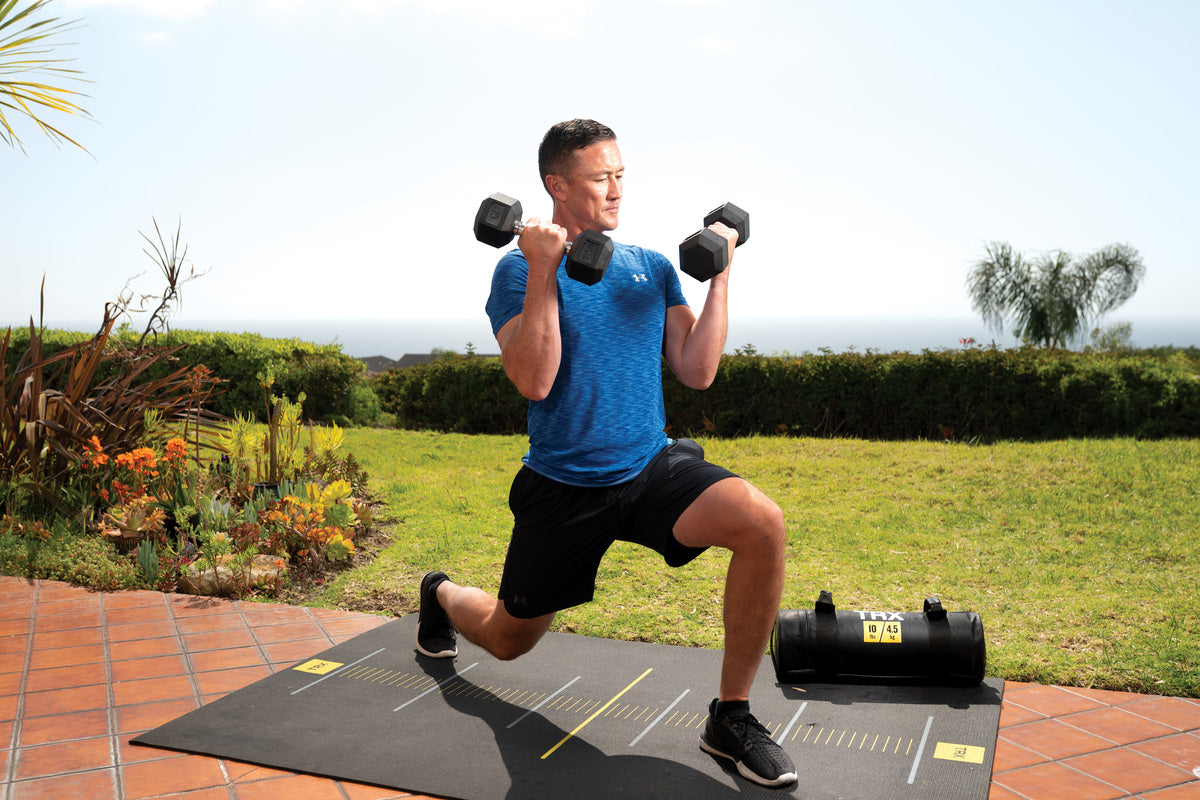Beginner’s Guide Full Body Dumbbell Workout Essentials

Beginner’s Guide: Full Body Dumbbell Workout Essentials
Introduction: Getting Started with Dumbbell Workouts
So, you’ve decided to embark on your fitness journey and incorporate dumbbell exercises into your routine. Congratulations! Dumbbells are versatile and effective tools for building strength and muscle, especially for beginners. In this beginner’s guide, we’ll walk you through the essentials of a full-body dumbbell workout to help you kickstart your fitness journey with confidence.
Understanding the Basics: What You Need to Know
Before diving into your first workout, it’s essential to understand the basics of dumbbell training. First and foremost, familiarize yourself with proper form and technique for each exercise to prevent injury and maximize results. Additionally, start with a weight that challenges you but allows you to maintain proper form throughout each set. As a beginner, focus on mastering basic movements such as squats, lunges, presses, rows, and deadlifts before progressing to more advanced exercises.
Designing Your Workout: Structuring a Beginner-Friendly Routine
When designing a beginner-friendly full-body dumbbell workout, it’s important to include exercises that target all major muscle groups. Aim for a balanced routine that incorporates both upper and lower body exercises to ensure comprehensive muscle development. Start with a dynamic warm-up to prepare your body for exercise, then move on to your main workout consisting of compound movements that engage multiple muscle groups simultaneously. Finally, finish with a cooldown and stretching routine to promote recovery and flexibility.
Sample Workout: Putting Theory into Practice
Now that you understand the basics, let’s put theory into practice with a sample full-body dumbbell workout for beginners:
- Goblet Squats – 3 sets of 10 reps
- Dumbbell Chest Press – 3 sets of 10 reps
- Bent-Over Rows – 3 sets of 10 reps
- Dumbbell Lunges – 3 sets of 10 reps per leg
- Dumbbell Shoulder Press – 3 sets of 10 reps
- Dumbbell Deadlifts – 3 sets of 10 reps
Perform each exercise with proper form and technique, focusing on controlled movements and engaging the targeted muscle groups. Start with lighter weights and gradually increase the resistance as you become more comfortable with each exercise.
Progression and Adaptation: Growing with Your Workouts
As you become more accustomed to your beginner’s dumbbell workout routine, don’t be afraid to challenge yourself and progress to heavier weights or more advanced exercises. Listen to your body and pay attention to how it responds to each workout, adjusting your routine accordingly. Additionally, consider incorporating variations and modifications to keep your workouts fresh and exciting while continuously challenging your muscles.
Staying Consistent: The Key to Success
Consistency is key when it comes to seeing results from your dumbbell workouts. Aim to exercise regularly, ideally three to four times per week, to maintain momentum and progress towards your fitness goals. Remember that progress takes time, so be patient with yourself and celebrate small victories along the way. With dedication, determination, and the right mindset, you’ll be well on your way to achieving your fitness aspirations with your beginner’s full-body dumbbell workout routine. Read more about full
Efficient Training Full Upper Lower Split Strategy

Unlock Your Full Potential with the Upper Lower Split Workout
Maximizing Gains with the Upper Lower Split Routine
Embarking on a fitness journey requires not just dedication but also a well-structured workout plan that caters to your goals. The Upper Lower Split Routine emerges as a powerhouse strategy, offering a balanced approach to building strength and muscle. By dividing your workouts into upper and lower body sessions, you can optimize your training regimen for maximum gains.
Understanding the Upper Lower Split Method
At its core, the Upper Lower Split revolves around targeting specific muscle groups on separate training days. Typically, you’ll dedicate one workout to your upper body muscles, such as chest, back, shoulders, and arms, and another to your lower body muscles, including legs and glutes. This division allows for focused attention on each muscle group, ensuring adequate rest and recovery between sessions.
Designing Your Upper Lower Split Program
Crafting an effective Upper Lower Split program begins with setting clear objectives and understanding your body’s capabilities. Start by outlining your fitness goals, whether it’s building muscle, increasing strength, or enhancing overall fitness. From there, tailor your workouts to align with these objectives, incorporating a mix of compound and isolation exercises to target various muscle groups.
Balanced Development through Targeted Workouts
One of the key advantages of the Upper Lower Split is its ability to promote balanced muscle development. By dedicating specific days to upper and lower body training, you can ensure that all major muscle groups receive equal attention. This balanced approach not only enhances overall strength but also reduces the risk of muscle imbalances and injuries.
Optimizing Training Efficiency with the Upper Lower Split Strategy
Efficiency is paramount when it comes to achieving fitness goals within a busy schedule. The Upper Lower Split offers a streamlined approach to training, allowing you to focus on a select group of muscles during each session. This targeted strategy maximizes workout efficiency, ensuring that every minute spent in the gym contributes to your progress.
Achieving Total Body Transformation
For those seeking comprehensive fitness transformation, the Upper Lower Split provides a solid foundation. By consistently following a well-designed program, you can sculpt your physique, boost strength, and improve overall athleticism. Whether you’re aiming to build muscle mass or enhance functional fitness, this versatile workout method can help you achieve your desired results.
Implementing Advanced Techniques for Progression
As you advance in your fitness journey, incorporating advanced training techniques can take your workouts to the next level. With the Upper Lower Split, you have the flexibility to integrate progressive overload, supersets, drop sets, and other methods to challenge your muscles and stimulate growth. By continuously pushing your limits, you can continue to make gains and surpass plateaus.
Customizing Your Upper Lower Split Regimen
Flexibility is key when it comes to designing a workout program that fits your individual needs and preferences. With the Upper Lower Split, you have the freedom to customize your routine based on factors such as training experience, fitness level, and
Sculpt Your Body Effective Full Body Weight Workouts
Achieve Total Fitness: Full Body Weight Training
Understanding Full Body Weight Workouts
Embarking on a fitness journey often leads to questions about the most effective workout routines. Full body weight training has emerged as a popular choice for individuals seeking comprehensive fitness gains. But what exactly does it entail?
The Science Behind Full Body Workouts
Full body weight workouts involve engaging multiple muscle groups in a single session. This approach is rooted in exercise science, leveraging the concept of compound movements to maximize muscle activation and calorie expenditure. By targeting various muscle groups simultaneously, these workouts deliver efficient and effective results.
Benefits of Full Body Weight Training
One of the key advantages of full body weight training is its time efficiency. Rather than dedicating separate days to different muscle groups, individuals can achieve a complete workout in a single session. This not only saves time but also ensures balanced muscular development and functional strength.
Sculpt Your Body with Comprehensive Exercises
Full body weight workouts encompass a wide range of exercises, from traditional lifts like squats and deadlifts to bodyweight movements like push-ups and pull-ups. This diversity allows individuals to tailor their workouts to their specific goals, whether it’s building muscle, burning fat, or improving overall fitness.
Unleash Your Strength Potential
Engaging in full body weight training challenges both muscular strength and cardiovascular endurance. By incorporating resistance exercises with minimal rest intervals, individuals can push their limits and unlock their full strength potential. Over time, this leads to noticeable improvements in strength, power, and stamina.
Customizing Your Workout Routine
The beauty of full body weight training lies in its versatility. Whether you’re a beginner or a seasoned athlete, there’s a workout routine that suits your needs. Beginners may start with lighter weights and fewer sets, gradually increasing intensity as they progress. Advanced lifters, on the other hand, can experiment with advanced techniques like supersets and drop sets to keep their workouts challenging.
Maximize Your Results with Proper Form
While intensity is important, proper form is paramount in full body weight training. Focusing on technique ensures maximum muscle engagement and minimizes the risk of injury. Beginners should seek guidance from certified trainers to learn correct form, while experienced lifters should periodically reassess their technique to prevent bad habits from forming.
Nutrition: The Fuel for Your Workouts
No workout routine is complete without proper nutrition. Full body weight training demands a balanced diet rich in lean proteins, complex carbohydrates, and healthy fats. These nutrients provide the fuel needed for intense workouts and support muscle recovery and growth.
Recovery: The Key to Progress
In the pursuit of fitness goals, many individuals overlook the importance of rest and recovery. Adequate sleep, hydration, and active recovery techniques are essential for optimizing performance and preventing burnout. Remember, progress is not just measured by what you do in the gym but also by how well you recover outside of it.
Progress Tracking: Stay Accountable
Tracking progress is essential for staying motivated and accountable. Whether it’s keeping a workout
Ultimate Full-Body Home Strength Routine No Gym Required
Unlock Your Full Potential with Home Full-Body Strength Workouts
The Rise of Home Workouts
In recent years, the fitness landscape has undergone a profound transformation. With the advent of technology and the ever-increasing demands of modern life, more and more people are turning to home workouts as a convenient and effective way to stay in shape. Gone are the days of expensive gym memberships and long commutes to the nearest fitness center. Now, all you need is a small space in your home and the determination to push yourself to new heights.
Breaking Down the Myths
One of the biggest misconceptions about home workouts is that they are somehow less effective than traditional gym sessions. However, nothing could be further from the truth. In fact, with the right approach, home workouts can be just as challenging and rewarding as any gym-based routine. By focusing on full-body strength training, you can build muscle, increase endurance, and boost your overall fitness levels without ever setting foot outside your front door.
Designing Your Full-Body Strength Routine
The key to a successful home workout program lies in its design. Rather than haphazardly throwing together a series of exercises, it’s essential to have a clear plan in place. Start by identifying your fitness goals and then tailor your routine to help you achieve them. For example, if you want to build muscle, focus on compound exercises like squats, deadlifts, and push-ups that target multiple muscle groups simultaneously. Conversely, if your goal is to improve cardiovascular health, incorporate high-intensity interval training (HIIT) into your routine.
Creating a Dedicated Space
Creating a dedicated workout space in your home is crucial for staying motivated and focused. Ideally, this space should be free from distractions and large enough to accommodate your exercise equipment. Whether it’s a spare room, a corner of your living room, or even just a cleared-out area in your garage, having a designated workout space will help you get into the right mindset and make it easier to stick to your routine.
Investing in Equipment
While you don’t need a lot of fancy equipment to get a great workout at home, investing in a few key pieces can help take your routine to the next level. Items like dumbbells, resistance bands, and a stability ball can add variety to your workouts and make them more challenging. Additionally, if space and budget allow, consider investing in larger pieces of equipment like a squat rack or a set of kettlebells. However, remember that you can still get a fantastic workout using just your body weight and whatever household items you have on hand.
Staying Consistent
Consistency is the key to success when it comes to home workouts. Just like with any other fitness program, you’ll only see results if you stick with it over the long term. Set aside dedicated time each day or week for your workouts, and treat them like any other important appointment. By making exercise a priority in your life and staying consistent with


